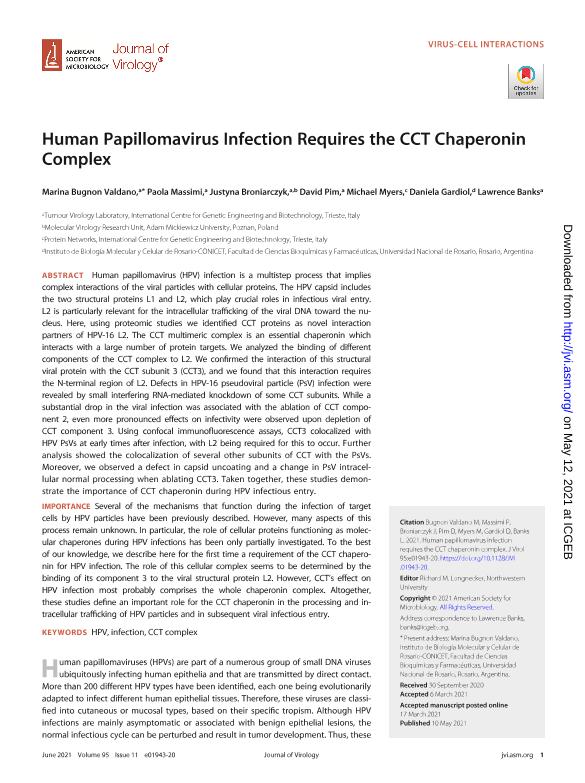Artículo
Human papillomavirus infection requires the CCT chaperonin complex
Bugnon Valdano, Marina Paula ; Massimi, Paola; Broniarczyk, Justyna; Pim, David; Myers, Michael; Gardiol, Daniela Nora
; Massimi, Paola; Broniarczyk, Justyna; Pim, David; Myers, Michael; Gardiol, Daniela Nora ; Banks, Lawrence
; Banks, Lawrence
 ; Massimi, Paola; Broniarczyk, Justyna; Pim, David; Myers, Michael; Gardiol, Daniela Nora
; Massimi, Paola; Broniarczyk, Justyna; Pim, David; Myers, Michael; Gardiol, Daniela Nora ; Banks, Lawrence
; Banks, Lawrence
Fecha de publicación:
06/2021
Editorial:
American Society for Microbiology
Revista:
Journal of Virology
ISSN:
0022-538X
Idioma:
Inglés
Tipo de recurso:
Artículo publicado
Clasificación temática:
Resumen
Human papillomavirus (HPV) infection is a multistep process that implies complex interactions of the viral particles with cellular proteins. The HPV capsid includes the two structural proteins L1 and L2, which play crucial roles in infectious viral entry. L2 is particularly relevant for the intracellular trafficking of the viral DNA toward the nucleus. Here, using proteomic studies we identified CCT proteins as novel interaction partners of HPV-16 L2. The CCT multimeric complex is an essential chaperonin which interacts with a large number of protein targets. We analyzed the binding of different components of the CCT complex to L2. We confirmed the interaction of this structural viral protein with the CCT subunit 3 (CCT3), and we found that this interaction requires the N-terminal region of L2. Defects in HPV-16 pseudoviral particle (PsV) infection were revealed by small interfering RNA-mediated knockdown of some CCT subunits. While a substantial drop in the viral infection was associated with the ablation of CCT component 2, even more pronounced effects on infectivity were observed upon depletion of CCT component 3. Using confocal immunofluorescence assays, CCT3 colocalized with HPV PsVs at early times after infection, with L2 being required for this to occur. Further analysis showed the colocalization of several other subunits of CCT with the PsVs. Moreover, we observed a defect in capsid uncoating and a change in PsV intracellular normal processing when ablating CCT3. Taken together, these studies demonstrate the importance of CCT chaperonin during HPV infectious entry. IMPORTANCE Several of the mechanisms that function during the infection of target cells by HPV particles have been previously described. However, many aspects of this process remain unknown. In particular, the role of cellular proteins functioning as molecular chaperones during HPV infections has been only partially investigated. To the best of our knowledge, we describe here for the first time a requirement of the CCT chaperonin for HPV infection. The role of this cellular complex seems to be determined by the binding of its component 3 to the viral structural protein L2. However, CCT’s effect on HPV infection most probably comprises the whole chaperonin complex. Altogether, these studies define an important role for the CCT chaperonin in the processing and intracellular trafficking of HPV particles and in subsequent viral infectious entry.
Palabras clave:
CCT COMPLEX
,
HPV
,
INFECTION
Archivos asociados
Licencia
Identificadores
Colecciones
Articulos(IBR)
Articulos de INST.DE BIOLOGIA MOLECULAR Y CELULAR DE ROSARIO
Articulos de INST.DE BIOLOGIA MOLECULAR Y CELULAR DE ROSARIO
Citación
Bugnon Valdano, Marina Paula; Massimi, Paola; Broniarczyk, Justyna; Pim, David; Myers, Michael; et al.; Human papillomavirus infection requires the CCT chaperonin complex; American Society for Microbiology; Journal of Virology; 95; 11; 6-2021; 1-20
Compartir
Altmétricas



